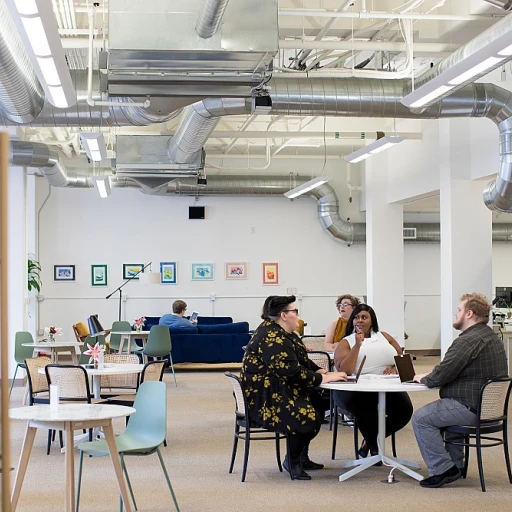Understanding the Modern Communication Landscape
The Dynamics of Communication in Modern Workplaces
In today's workplace, communication is constantly evolving. As organizations become more diverse and technologically advanced, the way we exchange information has rapidly transformed. This presents both opportunities and challenges for effective listening, an essential component in fostering employee engagement. Active listening requires intentional focus in any conversation. This skill is critical for managers and leaders striving to create a positive employee experience. By attentively hearing the speaker, observing body language, and understanding the message, individuals can enhance their communication skills. Several factors have reshaped the communication landscape:- Technological Advancements: Tools like video conferencing and instant messaging have made communication more accessible but have also introduced distractions. It's crucial for individuals to pay attention and engage in conversations thoughtfully.
- Cultural Diversity: In the United States and beyond, workplaces are increasingly multicultural. Understanding different listening styles and adapting your approach to accommodate these can enhance personal and professional relationships.
- Remote Work: As remote work becomes more common, effective listening becomes even more important. Maintaining eye contact via video calls and using verbal communication effectively can bridge the gap when physical presence is not possible.
The Role of Active Listening in Employee Engagement
Unleashing Engagement Through Attentive Interaction
To truly enhance employee engagement, it is crucial for managers and leaders to harness the power of active listening within the workplace. Engaging effectively with employees involves more than hearing their words; it demands paying close attention to both their verbal communication and body language. This approach not only strengthens communication skills but also fosters a more inclusive and supportive work environment.
Active listening is vital in today’s workplace as it encourages open dialogues and collaborations among employees. When leaders listen actively, they demonstrate empathy and understanding, essential components of robust employee engagement. This skill helps leaders adapt their communication styles to suit different individuals, thereby fostering a personalized, emotional connection. Such interactions can significantly influence an employee's decision-making process and overall job satisfaction. When people feel heard, they are more inclined to contribute innovative ideas and demonstrate loyalty to the organization.
However, not all communication styles are impactful. Active listening skills need to be honed through regular practice and commitment to personal professional development. Simple techniques such as maintaining eye contact, using affirming gestures, and reflecting back on what the speaker says can enhance active listening. Furthermore, understanding different listening styles and adapting accordingly can bridge communication gaps, fostering more effective interactions.
In the modern communication landscape, where time often feels limited, ensuring that each employee feels valued and understood is crucial. This commitment not only improves active participation but also strengthens engagement across the board, leading to a more cohesive and productive workplace environment.
Interested in learning more about how you can enhance employee experience through active listening strategies? Explore effective strategies for success.
Barriers to Effective Listening in the Workplace
Recognizing Challenges to Effective Listening
Effective listening is a crucial component of employee engagement, yet several barriers can impede this vital skill in the workplace. Understanding these challenges is the first step toward overcoming them and enhancing employee experience.
- Environmental Distractors: The modern office, with its open layouts and constant streams of communication, can be filled with unexpected noises and interruptions. These distractions can prevent individuals from focusing on the speaker, hindering their ability to listen attentively.
- Personal Biases: Personal prejudices and preconceived notions can act as significant barriers to listening. When individuals let their biases interfere, they may dismiss valuable information, ultimately affecting the quality of communication.
- Competing Priorities: Managers and employees often juggle multiple tasks simultaneously, leaving little time to engage in active listening. This multitasking can lead to misunderstandings as people fail to pay full attention to verbal communication.
- Formality and Hierarchy: Formal hierarchies may create communication barriers, especially when employees feel intimidated by speaking openly in front of leaders. In such scenarios, genuine dialogue takes a backseat to reserved conversation.
- Lack of Active Listening Skills: Without adequate training, many individuals in today's workplace may struggle with active listening. Participants in conversations might rely heavily on their own listening styles, overlooking crucial non-verbal cues like body language and eye contact.
Addressing these barriers requires not only recognizing them but also taking intentional steps to improve active listening skills. By addressing these challenges head-on, organizations can foster a culture where effective communication thrives, empowering employees at all levels to engage meaningfully.
Strategies for Improving Listening Skills
Enhancing Communication in the Workplace: Practical Listening Techniques
Active listening is key to improving communication skills in today's workplace. It requires intention, effort, and practice, but it significantly boosts employee engagement and personal professional relationships. Here are strategies to hone your listening skills:- Practice Mindful Listening: Focus fully on the speaker, setting aside distractions. This means putting down your phone, closing unnecessary tabs, and striving to be present in the conversation.
- Use Open Body Language: Non-verbal communication speaks volumes. Maintain eye contact, nod to show understanding, and avoid crossing your arms, as this may seem defensive.
- Adopt Different Listening Styles: Understand that each conversation requires a unique approach. Listen actively by varying your listening style based on the message and speaker’s needs, which improves effective communication.
- Engage Thoughtfully: Show that you're engaged not just by listening but by responding aptly. Ask questions to clarify the message and paraphrase to confirm understanding.
- Be Patient: Allow people to express their thoughts fully before you jump in with advice or opinions. Giving people time lets you understand their message completely.
Leveraging Technology for Better Listening
Harnessing Technology for Enhanced Listening
In today's rapidly evolving workplace, technology has become an invaluable tool for improving the listening skills of both leaders and employees. Advanced communication platforms and tools facilitate more effective exchanges, allowing speakers and listeners to engage more actively and attentively. As a result, fostering an environment of active listening becomes more achievable.
To leverage technology effectively, organizations can focus on the following strategies:
- Adopting Unified Communication Systems: Implementing platforms that combine voice, video, and text-based communication in a single interface helps streamline interactions. They allow participants to choose the most appropriate medium for exchanging messages, thus enhancing overall communication skills.
- Utilizing Collaboration Tools: Tools like Slack, Microsoft Teams, and Zoom are designed to support real-time communication and collaboration. By allowing people to engage in multiple modes of discussion—whether through chat, video, or shared documents—these tools improve the depth and breadth of conversations.
- Recording and Playback Features: Some communication platforms offer features that enable recording conversations for later playback. This function is essential for reinforcing active listening by allowing individuals to revisit meetings, ensuring they comprehend and retain each message.
- Speech-to-Text Technology: This is particularly useful for employees with different listening styles or those who benefit from written records of spoken communication. By transcribing the conversation, people can more readily engage with the content, enhancing their understanding and participation.
Effective management of these technological tools requires that managers and leaders actively promote their use while also providing training to improve employees' listening styles. This alignment between technology and active listening techniques will help raise the bar for effective communication within the workplace, paving the way for more meaningful employee engagement.
When technology is harnessed effectively, it acts as a bridge to overcome barriers in communication, amplifying the benefits of active listening and fostering a more inclusive, communicative work environment.
Measuring the Impact of Listening on Employee Experience
Evaluating Listening's Influence on Employee Satisfaction
Assessing the impact of listening on employee experience is crucial for understanding and improving the dynamics in the workplace. Effective listening can significantly contribute to employee engagement, job satisfaction, and overall productivity. Here’s how organizations can measure its influence:- Employee Feedback: Collect regular feedback from employees through surveys and one-on-one conversations. This can offer insights into whether they feel heard and valued, which is a direct result of effective listening practices.
- Performance Metrics: Identify changes in employee performance over time. Improved communication and active listening often lead to increased productivity, creativity, and problem-solving abilities.
- Engagement Levels: Track engagement metrics like participation in meetings, contribution to discussions, and voluntary involvement in workplace initiatives. Active listening can foster a more inclusive environment, encouraging employees to engage more.
- Turnover Rates: Monitor the employee turnover rates. A decline in turnover often indicates that employees feel their voices are heard and appreciated, influencing their decision to stay with the company.
- Leadership Assessments: Evaluate the listening skills of managers and leaders through 360-degree feedback or other evaluation methods. Effective leaders are typically strong listeners, which is reflected in their team’s performance and morale.








